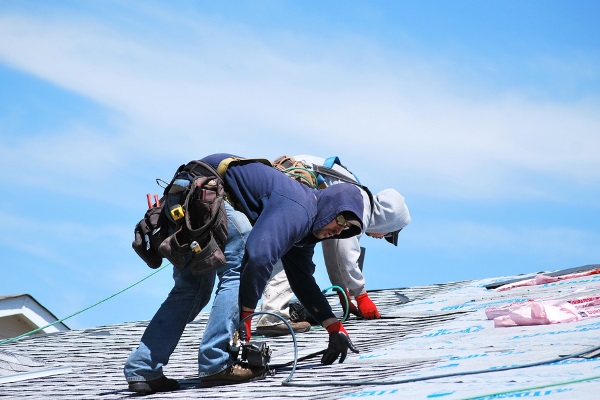Roofing is never an easy job. True enough, any job requiring climbing up ladders, keeping yourself in balance, and using upper body strength to carry equipment and force in nails is extremely difficult. However, with the new tools and procedures, how hard is roofing for Allen TX residents this 2019?
Indeed, the right tools drive down roofing laborer tasks. For example, using a nail gun instead of the traditional nail hammer makes asphalt shingle installation fast. Then again, this is just one part of roofing that anybody can handle.
Here are everything you may deal with when you plan to install your roofs by yourself.
Is Residential Roofing Truly Difficult?
- Tools every roofer needs (5 Items)
- A typical roof installation procedure (5 items)
- DIY vs Professional Roofer
How Hard is Roofing: Essential Tools You Need
Roofing Nailers
Is roofing a trade? Indeed, it is. If you know how to be a good roofer and how to run a roofing crew, then you can definitely nail it in the industry.
Speaking of nails, every roofer knows roofing nailers are an essential roofer’s tool. Average roof nailers cost $200-$300 while professional-level equipment cost about $400-$500 apiece.
Nailguns make roof installations fast and quick with each nail driven in full precision without additional vibrations that can crack the material.
Specialty Knives
Does roofing make you strong? Definitely, especially for those who know how hard is roofing. Roofers need great upper body strength to carry equipment and use hammers to drive nails.
Perhaps the hardest part of roofing is lacking in necessary equipment when doing work. Every roofer carries a utility knife. In fact, it is part of the professional aesthetic as a gun is to a police officer.
Utility knives can cut asphalt shingles, underlayment, and other roofing materials quickly. Alternatively, you can use hook blades or heavy-duty knives for heavy-duty roofing material. They only cost $20-$30 individually.
Material Rippers
Is roofing dangerous? Extremely, especially without the right tools and knowing how hard is roofing. Anyone who does roofing understands they need to take extra care doing work and have the right materials.
Material rippers such as pry and crow bars are extremely necessary for any roofing job. They will dislodge old roofing material, which is extremely important when you plan to tear off and replace your existing roof.
A standard pry bar costs about $20-$30 from most suppliers.
Harness
Roofing is difficult enough that you’ll need a harness in virtually every project. You won’t use harnesses on the roof itself. Professional contractors use it to keep themselves on the roof and avoid fall accidents.
True enough, roofs are extremely hazardous work environments. A slight imbalance can mean you falling to the floor. Therefore, harnesses and ropes allow you to rappel and slow your fall in case of any accident.
A typical roof harness costs about $30-$50 from most hardware and roofing suppliers.

Safety harnesses protect roofers from any possible fall from the high areas of a property.
Seam Roller
Roofing underlayment and felt paper requires no bubbles to work effectively. You can purchase a convenient seam roller for just $30-$40 from most suppliers. These flatten and remove air underneath your underlayment and make sure the adhesive sticks right on top of your roof deck efficiently.
The Typical Roof Installation Method
Install Self-Adhering Underlayment
On paper, roofing seems easy. However, it takes much time and effort to complete roofing projects. First, you’ll need to collect all necessary materials and equipment such as your roofing underlayment and material. Next, you’ll need to install the roofing underlayment first.
An underlayment protects your roof deck against ice dams and extremely strong rain. After peeling off the plastic back, you’ll expose the self-adhesive roofing underlayment. Make sure to unroll it on your roof and use a seam roller to flatten it out.
Install underlayment material in sequences that overlap each other. An inch is enough to secure the roof deck against leaks.
Related: How To Stop a Roof Leak in the Rain
Secure Valley Flashing
During rains, your roof valleys pool with huge torrents of water. Therefore, giving them extra protection with metal flashing and roofing underlayment is a must.
Apply roofing underlayment before you install any metal flashing on your roof valleys. In doing so, you reduce the likelihood of leaks that land inside the roofing deck itself. Doing this is easy.
First, you must cut enough roofing underlayment under your valleys. Make sure it extends towards the drip edge of your roof. Next, place enough felt paper on the underlayment before laying down metal flashing.
Install Starter Course Roof Shingles
Once you secure all vulnerable roofing areas, you can lay down the first asphalt shingle course.
Most roofers use half of a shingle as their starter course. At this point, the roofing knife becomes essential in cutting shingles in half, 3/4, or 2/4 its size as you continue on other courses.
For every three-tab asphalt shingle you lay down, make sure to use your roofing nails on the top corners of each one to secure them. Do this for the other squares of your roof.
True enough, this will be the most time-consuming aspect of installing your roof.
Install Ridge Cap Shingles
You can order specialty ridge cap shingles from suppliers or manufacturers. If your set didn’t come with one, you can bend an asphalt shingle and reduce its length to serve as a ridge cap.
The valleys and ridges of your roof are most vulnerable to leaks. Therefore, additional protection in any form is helpful. Ridge and valley cap shingles seal the corners and seams that rainwater can penetrate.
Furthermore, be careful when working on roofing ridges. They’re often the highest and most unstable roofing areas, so make sure you’ always have good footing.

Even if you came prepared, roofing accidents can happen at any time especially when working on roofing ridges.
Perform Final Checks
To know if you did a great roofing job, bring up a garden hose with you. Then, let the water run in the different areas of your roof.
Have someone check the internal condition of your roof. If you spot any leaks, you’ll need to patch the roofing underlayment and material gap on your roof.
Here is a great way to make sure your roof is definitely watertight and ready to face extreme weather conditions.
Related: Best Roof Materials to Replace Your Roof Today

Working with a contractor is a great option for anyone in need of excellent roofing installations
Should I Do It Myself or Call a Roofing Company?
Is roofing a seasonal job? Indeed, it is. It is one reason why most Allen TX homeowners consider doing DIY roofing. However, it can be a difficult task especially if you have less time to spare. Now that you know how hard is roofing, you can make estimates on how many weekends you’ll need to do your roof installation.
Imagine having your weekends spent re-roofing your home when you can relax and spend more time for yourself or your family instead. In addition, without experience, you’re putting yourself at risk of danger. Unless you’re truly passionate about roofing and would love to be part of the industry, it pays little to do roofing by yourself.
Instead, you can consider hiring an Allen TX roofing company such as Storm Pros. With our experience, knowledge, equipment, and capability, we can definitely give you the roofing service you need. Contact us today!

Recent Comments